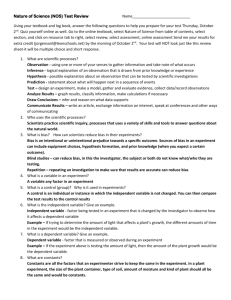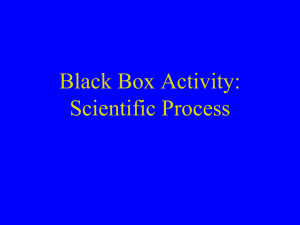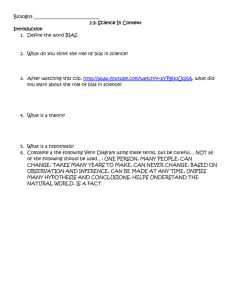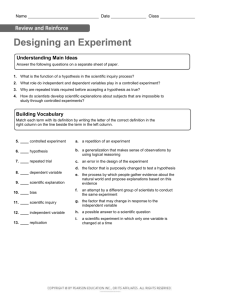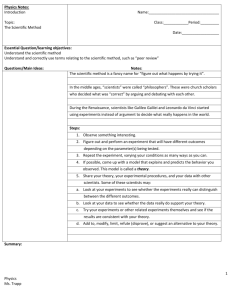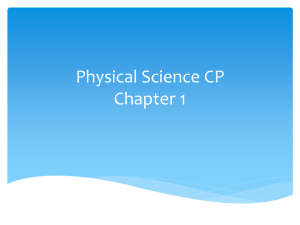Chapter 1, Section 1 Guided Notes
advertisement
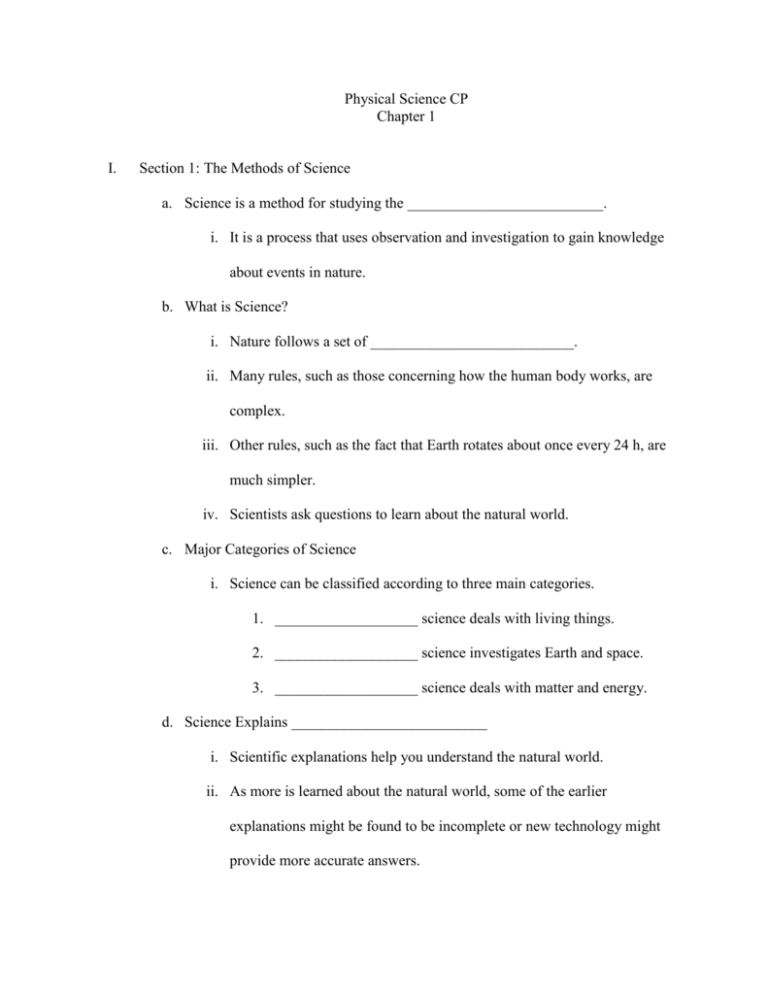
Physical Science CP Chapter 1 I. Section 1: The Methods of Science a. Science is a method for studying the __________________________. i. It is a process that uses observation and investigation to gain knowledge about events in nature. b. What is Science? i. Nature follows a set of ___________________________. ii. Many rules, such as those concerning how the human body works, are complex. iii. Other rules, such as the fact that Earth rotates about once every 24 h, are much simpler. iv. Scientists ask questions to learn about the natural world. c. Major Categories of Science i. Science can be classified according to three main categories. 1. ___________________ science deals with living things. 2. ___________________ science investigates Earth and space. 3. ___________________ science deals with matter and energy. d. Science Explains __________________________ i. Scientific explanations help you understand the natural world. ii. As more is learned about the natural world, some of the earlier explanations might be found to be incomplete or new technology might provide more accurate answers. iii. Scientists have studied the atom for more than two centuries. iv. Thompson and Rutherford’s both created models to help explain their understanding of an atom. v. Today we use a different model called the electron cloud model. vi. This model is a result of many investigations and collaboration of many scientists. vii. Because it is the nature of science to be open to change, investigations into the model of the atom continue today. e. _________________________________ i. Scientists learn new information about the natural world by performing investigations, which can be done in many different ways. ii. Some investigations involve simply observing something that occurs and recording the observations. iii. Other investigations involve setting up experiments that test the effect of one thing on another. iv. Some investigations involve building a model that resembles something in the natural world and then testing the model to see how it acts. f. Scientific Methods i. An organized set of investigation procedures is called a scientific method. ii. Six common steps found in scientific methods are shown. 1. ___________________ a. Many scientific investigations begin when someone observes an event in nature and wonders why or how it occurs. b. Then the question of “why” or “how” is the problem. c. Sometimes a statement of a problem arises from an activity that is not working. 2. __________________________ a. Before testing a hypothesis, it is useful to learn as much as possible about the background of the problem. b. Have others found information that will help determine what tests to do and what tests will not be helpful? 3. _____________________________ a. A hypothesis is a possible explanation for a problem using what you know and what you observe. b. For example, NASA scientists hypothesized that a ceramic material might withstand the heat and forces of reentry and could work on the space shuttle. c. Testing a Hypothesis i. Some hypotheses can be tested by making observations. ii. Others can be tested by building a model and relating it to real-life situations. iii. One common way to test a hypothesis is to perform an experiment. iv. An experiment tests the effect of one thing on another using controlled conditions. iii. Variables 1. A ____________________ is a quantity that can have more than a single value. 2. You might set up an experiment to determine which of three fertilizers helps plants to grow the biggest. 3. Possible factors include plant type, amount of sunlight, amount of water, room temperature, type of soil, and type of fertilizer. 4. In this experiment, the amount of growth is the ______________ variable because its value changes according to the changes in the other variables. 5. The variable you change to see how it will affect the dependent variable is called the _________________________ variable. iv. Constants 1. A factor that does not change when other variables change is called a ____________________________. 2. You might set up four trials, using the same soil and type of plant. 3. Each plant is given the same amount of sunlight and water and is kept at the same temperature. These are constants. v. Controls 1. The fourth plant is not fertilized. 2. This plant is a control. A control is the standard by which the test results can be compared. vi. Analyze the data 1. An important part of every experiment includes recording observations and organizing the test data into easy-to-read tables and graphs. 2. Interpreting the data and analyzing the observations is an important step. 3. If the data are not organized in a logical manner, wrong conclusions can be drawn. vii. Draw conclusions 1. Based on the analysis of your data, you decide whether or not your hypothesis is ______________________________. 2. For the hypothesis to be considered valid and widely accepted, the experiment must result in the exact same data every time it is repeated. g. Being objective i. A ___________________ occurs when what the scientist expects changes how the results are viewed. ii. Scientists can lessen bias by running as many trials as possible and by keeping accurate notes of each observation made. iii. The experiment must be ____________________________. iv. Findings are supportable when other scientists perform the same experiment and get the same results. v. _______________ experiments also must have data that are measurable. h. Scientific Theories and Laws i. A scientific theory is an explanation of things or events based on knowledge gained from many observations and investigations. It is not a guess. ii. Just because a scientific theory has data supporting it does not mean it will never change. iii. A scientific law is a statement about what happens in nature and that seems to be true all the time. vi. Laws tell you what will happen under certain conditions, but they don’t explain why or how something happens. vii. Gravity is an example of a scientific law. viii. A theory can be used to explain a law, but theories do not become laws. ix. For example, many theories have been proposed to explain how the law of gravity works. x. Even so, there are few theories in science and even fewer laws.


